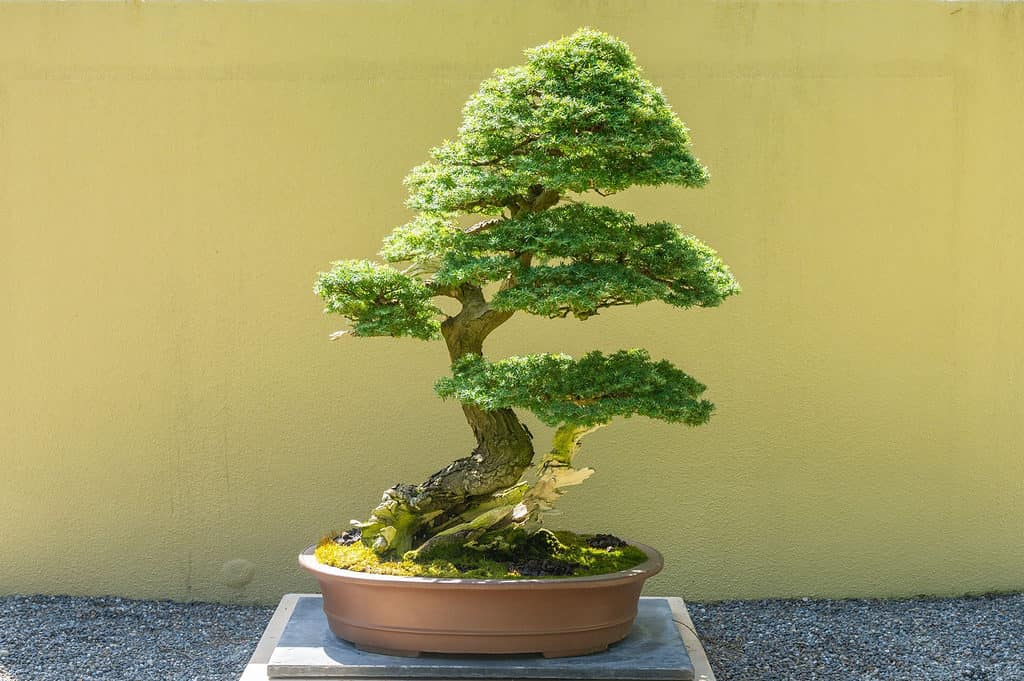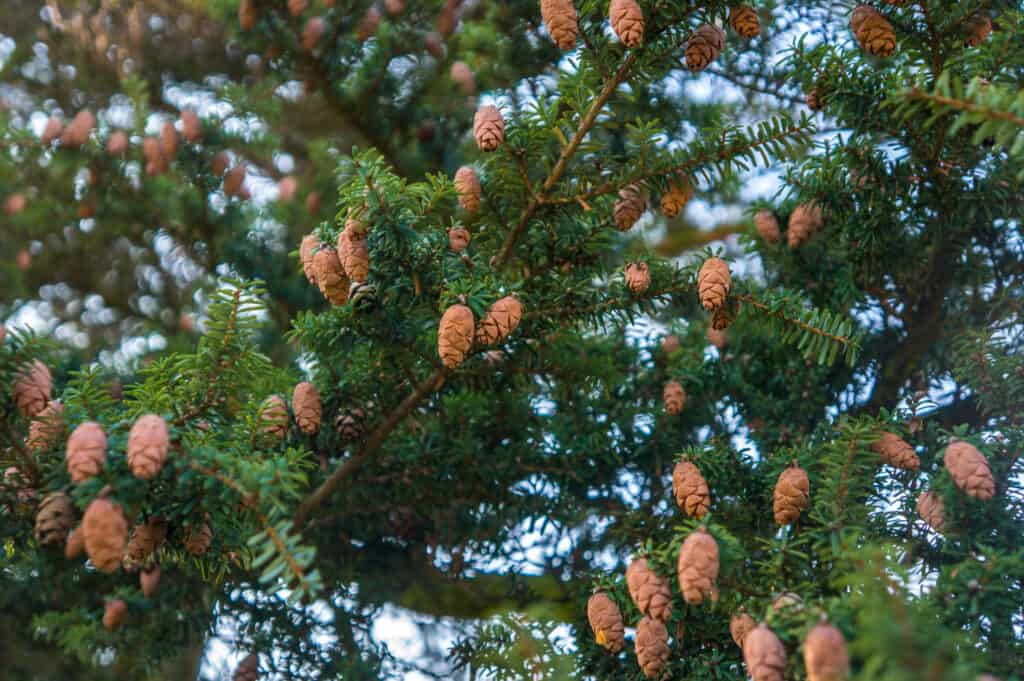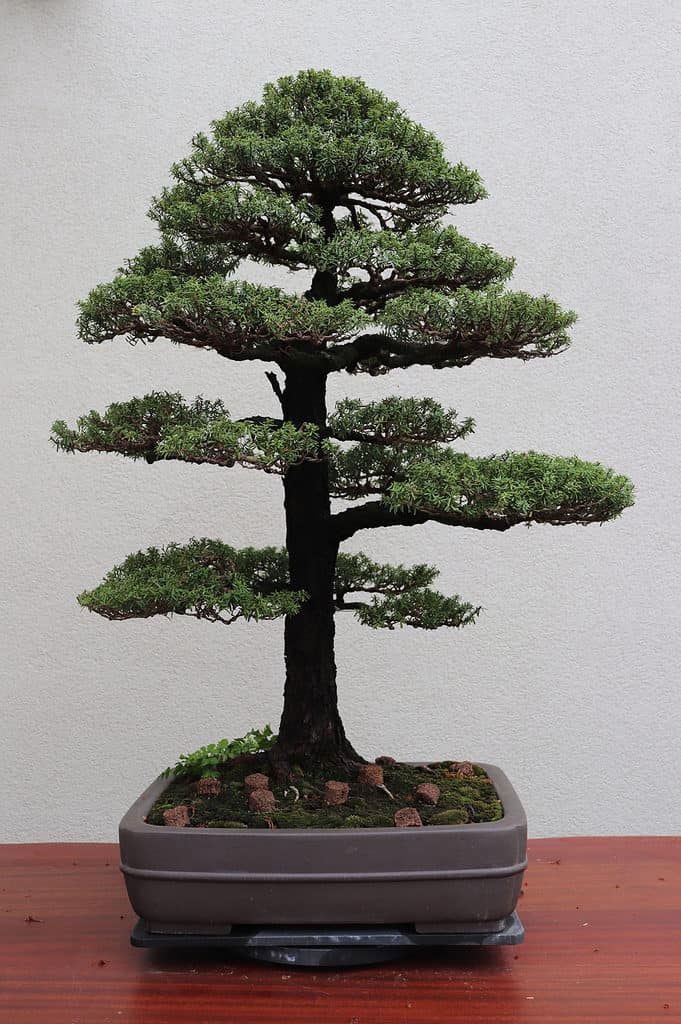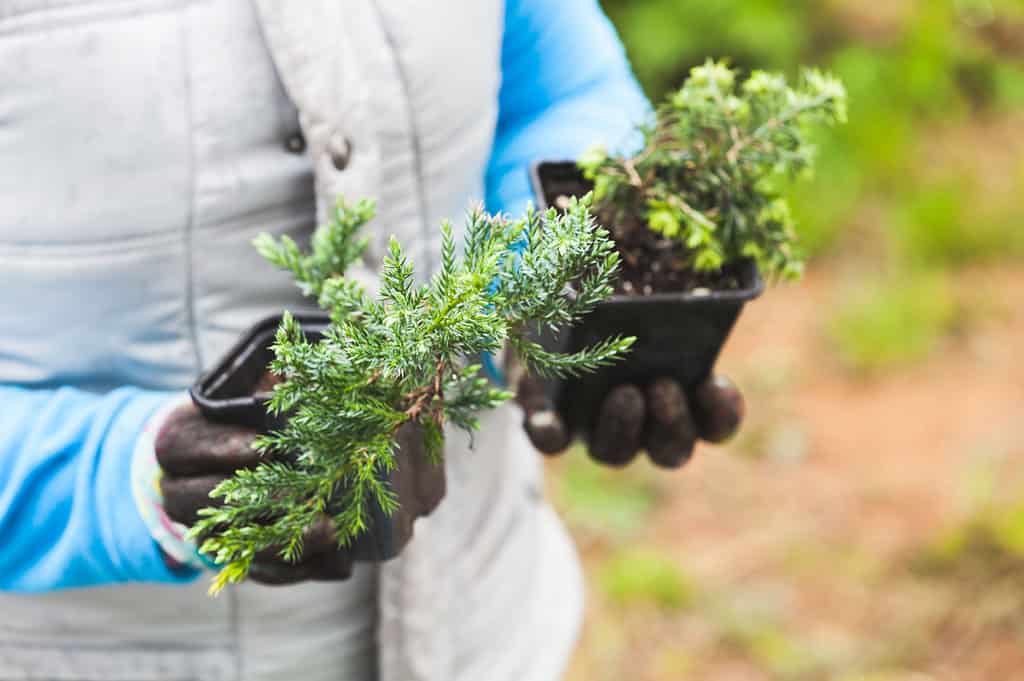Hemlock trees are known for their towering, majestic beauty. This is something that can be easily reproduced in Bonsai tree art. Hemlock trees make perfect Bonsai trees, especially for beginners, because they are adaptable and easy to take care of. What are the most common types of hemlock Bonsai trees? How do you care for them?
Here is everything you need to know about growing a hemlock Bonsai tree!

The western hemlock makes a great Bonsai tree specimen.
©Mariusz S. Jurgielewicz/Shutterstock.com
| Hemlock Bonsai Tree Facts | |
|---|---|
| Botanical Name | Tsuga |
| Common Types | Eastern hemlock, Western hemlock, Mountain hemlock, Carolina hemlock, Taiwan hemlock, Northern Japanese hemlock, Southern Japanese hemlock, Himalayan hemlock |
| Sunlight | Full sun to partial shade |
| Soil | Soil requirements differ from type to type, but for the most part, regular Bonsai soil mixtures should work just fine. |
| Water | Hemlock trees need less water than usual. Take care to keep the rootball from drying out completely. |
| For Beginners? | Beginner to intermediate. Hemlock Bonsai trees are easy to care for, but they can be shaped into many challenging styles. |
| Indoors or Outdoors? | Indoors and outdoors, depending on the season and the environment. |
| Pairs Well With… | Moss, grass, and other natural ornamentation |
Common Types of Hemlock Bonsai Trees

Hemlock trees can endure heavy snowfall and even ice storms, but your hemlock Bonsai tree will need winter protection!
©iStock.com/Sara Lissaker
There are about 10 different types of hemlock trees in the world. They are all tall, majestic evergreen trees. Each of them is as beautiful as the others and would make a perfect Bonsai tree. Here are the most common hemlock Bonsai trees!
Eastern Hemlock
Eastern hemlock trees are occasionally called Canadian hemlock trees. These trees are native to the eastern regions of North America. Eastern hemlock trees have a very slow growth rate. Most of the time, it can take about 20 years for these trees to reach their full height. However, they tend to live much longer than most other trees. There are plenty of Eastern hemlock trees that are thousands of years old.
Eastern hemlock trees can grow in shade though they do need at least partial sunlight to grow their best. They prefer well-draining soil and they can survive brief periods of drought. Take care to keep your Eastern hemlock from harsh winter winds, however.
Western Hemlock
Western hemlock trees are native to the western regions of North America. They can be found throughout Alaska and down to California. Western hemlocks do not live as long as their eastern cousins, but they grow taller. They can eventually reach up to, or even more than, 150 feet tall. As these trees mature, their bark thickens. This is different from most other trees, whose bark is often weaker the older the tree is.
Western hemlock trees thrive best in moist, acidic soil. They are susceptible to heat and drought and must be protected from these conditions.
Mountain Hemlock
Mountain hemlock trees are native to the western coast of North America. They are also called black hemlock trees. They can reach heights of 100 feet or even more. This can happen if they are planted in moist, acidic soil. As a whole, mountain hemlock trees can grow very well beneath shade, though they do need at least partial sunlight from time to time.
Carolina Hemlock
Carolina hemlock trees are native to North America and can be found throughout the Appalachian Mountain Range in the United States and Canada. When planted naturally these trees can reach a height of about 100 feet. They thrive best beneath partial shade, in moist, well-draining soil. But they do not do well in heat and must be protected from hot temperatures.
Taiwan Hemlock
Taiwan hemlock trees look far different from the average hemlock trees, especially the ones native to North America. But that is just part of their charm! They are native to Asia and can be found throughout Taiwan, China, and Tibet. They can reach a height of 150 feet. Taiwan hemlock trees grow best in rocky areas, especially mountains. They can tolerate different types of soil, and they prefer cool, wet environments.
Northern Japanese Hemlock
Northern Japanese hemlock trees are native to Japan. When they start growing, their rate of growth is definitely slower than other hemlock trees. But as they get older and mature, they begin growing faster. These hardy trees can survive cold winter temperatures. They need full sunlight to thrive, as well as moist, well-draining soil.

The average Japanese hemlock Bonsai tree produces dark bark.
©Lilly Kauffman/Shutterstock.com
Southern Japanese Hemlock
The Southern Japanese hemlock tree is native to Japan, but it can also be found throughout South Korea. Southern Japanese hemlock looks very different when compared to their northern cousins. They are thicker and denser, like massive Christmas trees. When planted naturally, they can eventually reach a height of 100 feet.
Southern Japanese hemlock trees thrive best in moist, well-draining soil that is somewhat acidic. They prefer full sun to partial shade.
Himalayan Hemlock
Himalayan hemlock trees are native to Southern Asia. They can be found throughout Tibet, Bhutan, Nepal, India, Myanmar, and Vietnam. They can grow anywhere from 75 feet to even 130 feet when planted or found in the wild.
These hardy trees can survive cold winter temperatures. Himalayan hemlocks thrive best in wet, humid environments.
Caring for Your Hemlock Bonsai Tree

You can grow a hemlock Bonsai tree from seed, but using an established plant will take less time.
©Evannovostro/Shutterstock.com
For the most part, caring for a hemlock Bonsai tree is easy. They can tolerate brief periods of drought and do not need to be pruned as often as other Bonsai trees.
Here are some tips on caring for your hemlock Bonsai tree so that it can grow its best!
Sunlight
Most hemlock trees do best in full sun to partial shade. There are some that tolerate shade more than others. However, as a whole, hemlock trees do not do well in hot temperatures. During the heat of the summer months, it is best to keep your hemlock bonsai tree in partial shade. This will protect it from heat and harsh sunlight.
Soil Type
Hemlock bonsai trees need moist, well-draining soil. Some of them prefer this soil to be on the acidic side. They would benefit from regular Bonsai tree soil mixtures, as these mixtures are designed to be well-draining.
Water
Hemlock bonsai trees do not need to be watered too much. Water your hemlock Bonsai tree when the rootball is dry, but take care to not let the rootball dry out entirely. If possible, try to not use hard water as it might be too rough on your hemlock bonsai tree. You can use rainwater to water these trees, though!
Placement
Deciding where to place your Bonsai tree can be a difficult part of the process. Fortunately, while hemlock trees can be picky about where they grow, they are a bit forgiving.
Hemlock Bonsai trees enjoy sunlight that isn’t too warm. When temperatures are cool to warm, you can place your hemlock bonsai tree where the sun will find it. But be careful when temperatures rise. During the heat of the summer months, it is best to keep your hemlock bonsai tree in partial shade. This will protect it from heat and harsh sunlight.
Some hemlock trees are hardier than others when it comes to cold winter temperatures. They tolerate frost relatively well, but not harsh, freezing winds. Keep your hemlock bonsai tree safe from these winds, if you can.
Pruning Your Hemlock Bonsai Tree

No matter the type of Bonsai tree, chances are high you’ll need wire.
©GrooTrai/Shutterstock.com
As a whole, hemlocks are slow-growing trees. This means that it may take some time before your hemlock is ready to be pruned. Usually, after a year or so, the hemlock bonsai can be pruned. In the winter months, you should do most of the pruning.
Ideal Hemlock Bonsai Tree Styles
Since hemlock trees are hardy and strong, they can be shaped into many dramatic Bonsai tree styles. They suit the Han-kengai style as well as they suit the Chokkan style. A style that is a little less challenging than Han-kengai but still just as striking is the Shakan style. Because hemlock trees grow so slowly, they are easier than other types to shape and style.
Propagating Your Hemlock Bonsai Tree
Hemlock Bonsai trees can easily be propagated from cuttings or seeds. The best time to propagate a hemlock Bonsai tree is in the summer. If you plan on propagating from cuttings, try to make sure the cuttings are at least semi-mature. This will give you more success at growing your hemlock Bonsai tree!
Common Problems with Hemlock Bonsai Trees
As a whole, hemlock trees rarely have problems with pests, insects, diseases, and other issues.
The photo featured at the top of this post is © Mariusz S. Jurgielewicz/Shutterstock.com
Thank you for reading! Have some feedback for us? Contact the AZ Animals editorial team.






